I’ve always enjoyed seeing alternate versions of famous photographs. Maybe frame #22 is the photo everyone knows about, while frames #18-21 have faded into obscurity – despite showing the same subject with minor variations. Of course, it’s not just famous photographers. Every photographer out there has an “almost portfolio.”
The reason why I’m writing about this topic is that, in most cases, photographers put a lot of thought into selecting which photos make the cut and which ones don’t. Personally, I’ve made the wrong decision here a few times and printed/published a variation that I ended up not liking as much. Below, I’m going to show some close variations of some of my photos and explain how I decided on the version I prefer, including why I initially made the wrong choice. Hopefully it will be an interesting demonstration and give you some ideas on how to find the best variation from the start.
The Grand Mosque of Abu Dhabi
On Photography Life’s most recent workshop in the UAE and Jordan, our group spent an afternoon taking pictures at the Grand Mosque of Abu Dhabi. The architecture here is simply stunning, with brilliant white pillars reflected in a series of blue pools outside the mosque. It makes for a great location for photography, but the sheer number of potential subjects can make it difficult to figure out what to spend the most time on.
Alternate
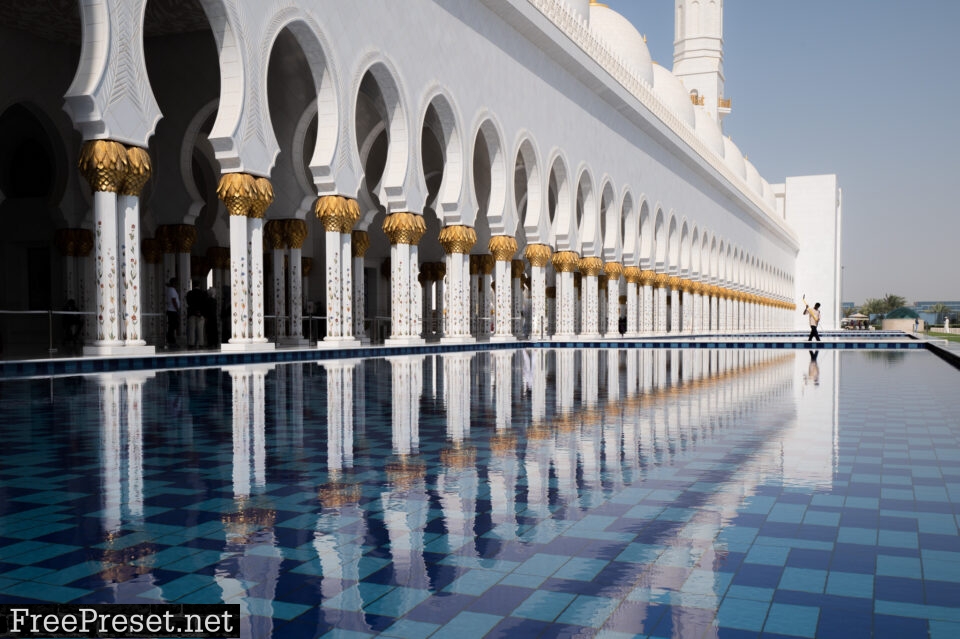
Portfolio Shot
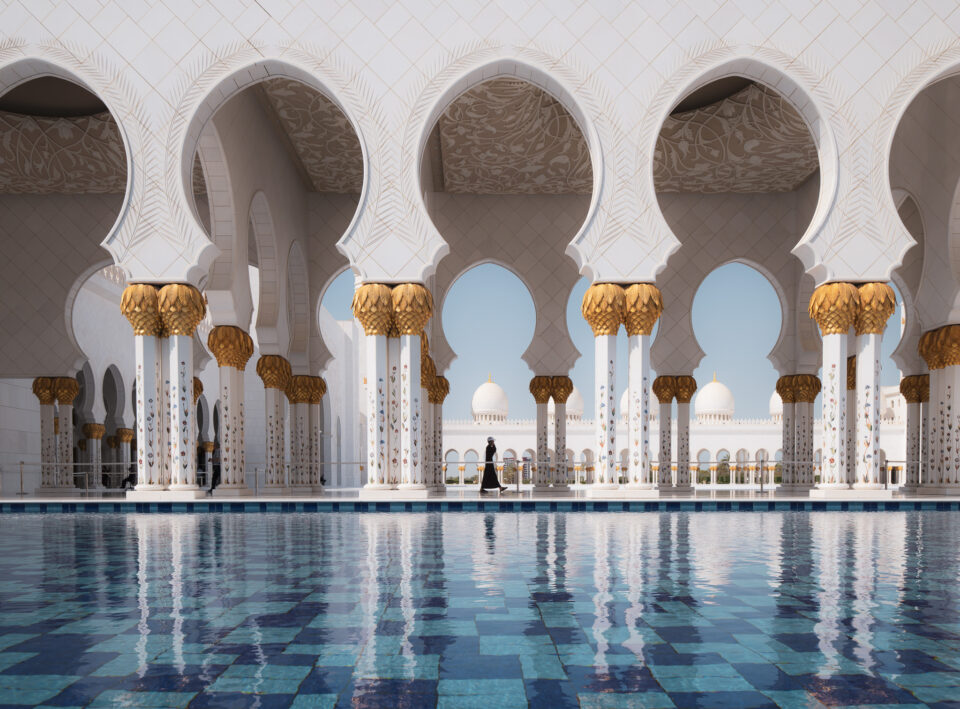
Background Info
Although I currently prefer the portfolio photo pretty clearly over the alternate, it was the other way around at first. When I was taking these pictures, I felt pretty strongly that the diagonal composition of the first photo would work better, and I spent much more time trying to capture that picture as a result.
In fact, I actually took the portfolio image first without too much thought (see photography from the heart and head). I then spend the next half hour taking various diagonal compositions, waiting and waiting for the right person to walk by.
Sometimes, too many people walked through the frame:
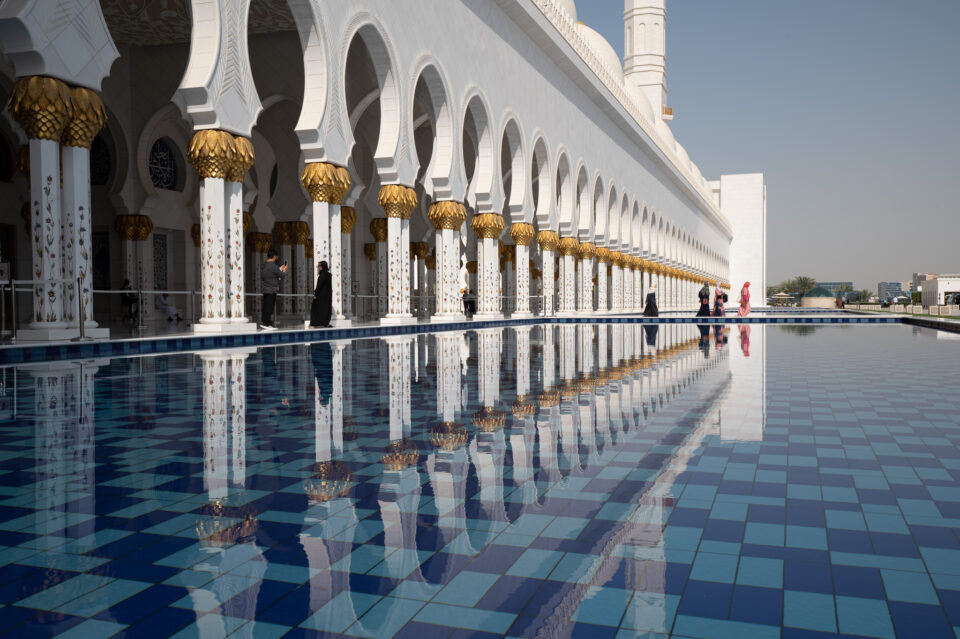
Other times, the subject’s clothes faded into the background too much:
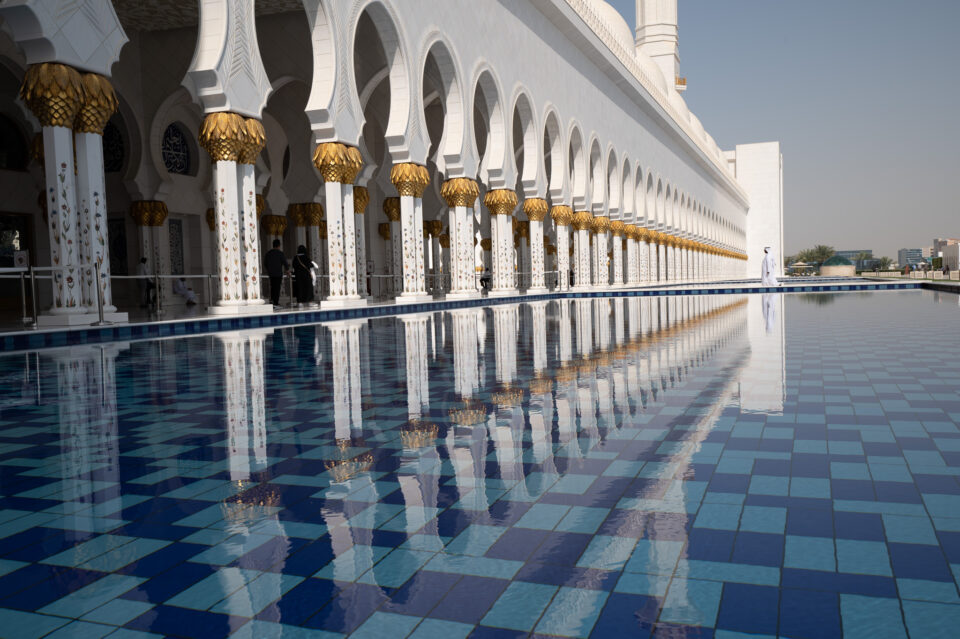
But, eventually, the staff at the mosque closed that particular pathway and began cleaning it, which led to the composition that I nearly ended up using:

There are still a few things wrong with this photo. First, the subject is facing out of the photo, which I don’t think works as well as the other way around. Second, although he isn’t wearing white, his tan shirt is still light enough that it fades a bit more than I’d like into the background. Third, the diagonal composition as a whole – which I thought would give the photo a nice sense of movement – feels somewhat overcomplicated to me now.
Instead, the head-on composition from my portfolio photo tells a simpler story and conveys the same emotional message without as many distractions. There’s more breathing space in the frame, and the subject is more distinct as well (largely because of the silhouette lighting). To top it off, the timing/position of this subject is simply much better. I got very lucky to capture this person’s stepping motion right as they walked under the center of the archway.

Why I chose this photo:
- Simpler, clearer message with fewer distractions
- Primary subject (the person) is more distinct
- Better timing and position of the subject
Why I liked the alternate better at first:
- Required more effort to capture (a long time waiting while baking in the sun)
- It shows a more unusual moment (subject is cleaning rather than walking)
Dream Lake at Sunrise
After running uphill through knee-deep snow right at sunrise – my punishment for hitting snooze too many times – I was completely out of breath, but also in awe of one of the most amazing landscapes I had ever seen. This is Dream Lake in Rocky Mountain National Park, now among my favorite places in the world. It’s also a hike where I’m bringing snowshoes next time ‘round.
Alternate
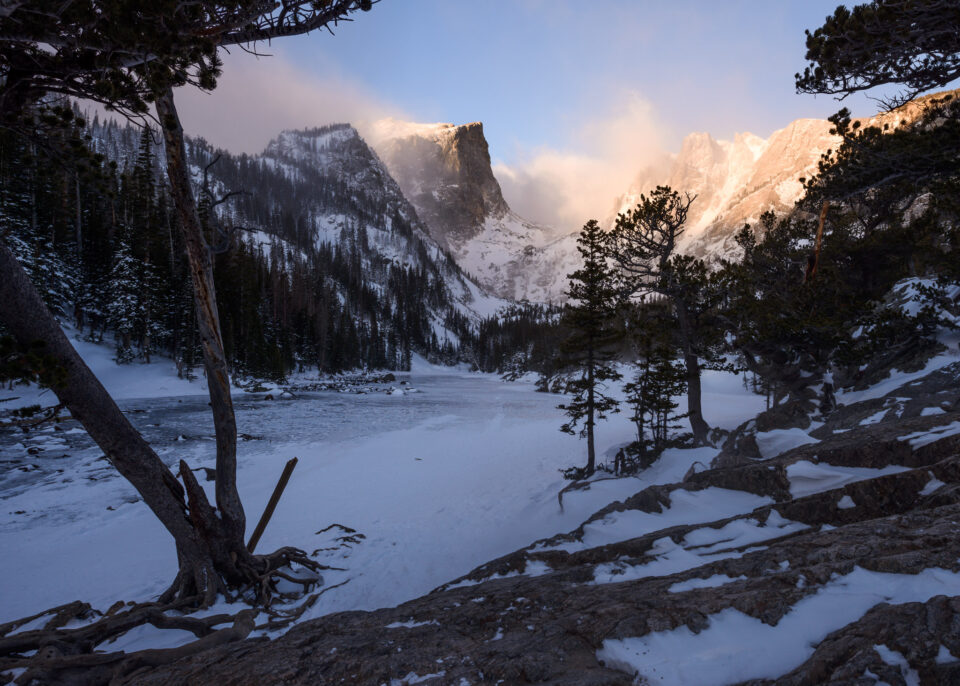
Portfolio Shot
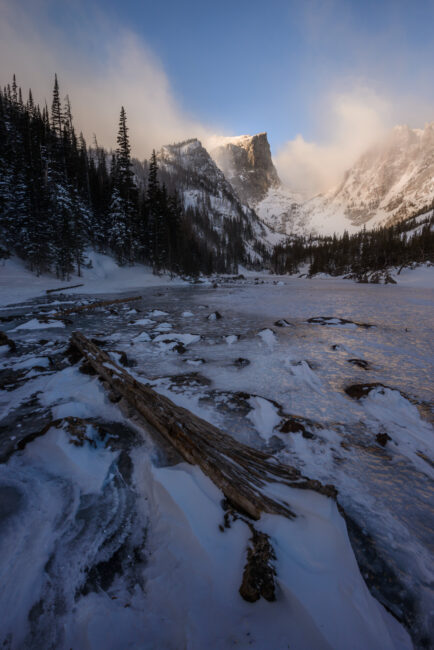
Background Info
Sometimes, landscape scenes with a stunning background – but no obvious foreground – are very difficult to photograph well. Do you switch to your telephoto lens and cut out the foreground entirely? Do you kludge a foreground out of something you normally wouldn’t use in your photo? Or, is it better to spend all your time trying to find a genuinely good foreground, where one may not even exist?
I did all three that morning at Dream Lake. It was my first time at the location, so I couldn’t rely on compositions I’d scouted earlier, and the sunrise was getting less vivid by the minute.
Here’s one of the telephoto variations I took, which I think cuts out too much context, since it doesn’t even show the frozen lake at all:
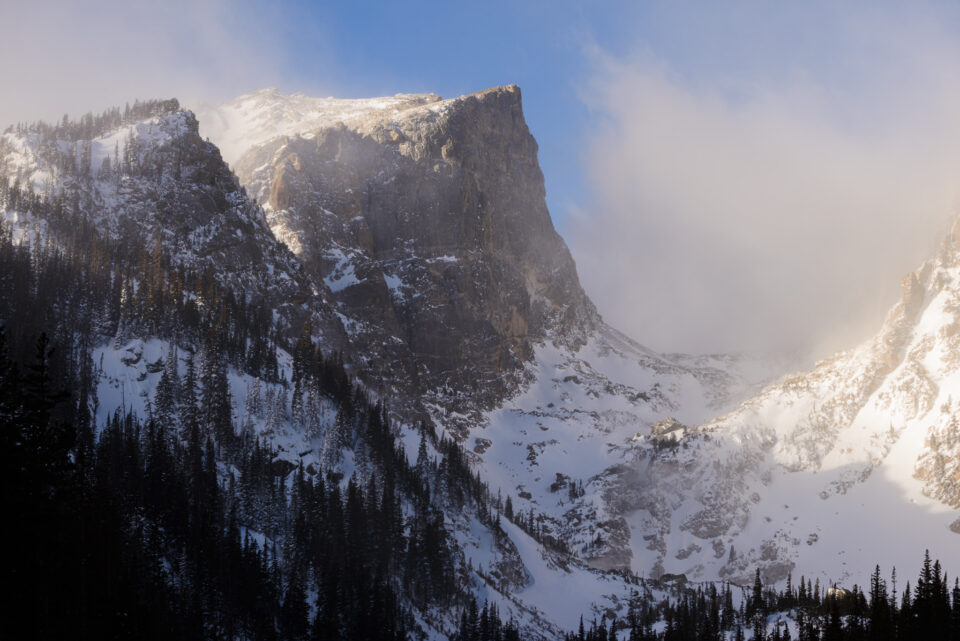
And a version with a kludgy foreground, which isn’t terrible, but doesn’t add much interest to the photo:
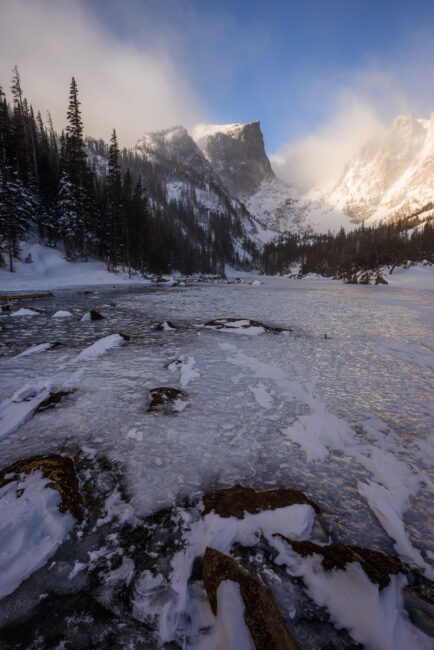
Seeing variations like these and feeling underwhelmed, I initially gravitated toward a composition that used some nearby trees and rocks as a “frame” around the image:

This type of composition is fairly common to see in landscape photography, perhaps unsurprisingly. “Framing” your photo with silhouetted trees (or similar) gives the photo a natural vignette. It draws your viewer’s eye to the well-lit subject, while blocking off the edges of your photo and creating a composition that feels intentional.
The trouble is, that’s why these compositions are so seductive, when they don’t always work as well in hindsight! On the back of a camera screen or as a thumbnail in Lightroom, this version of the photo stands out more (at least to me) and seems like it would be better than the one I ultimately selected.
But with some more thought and time to step back, the “story” of this photo just isn’t as strong. Why are there trees randomly covering the photo? Do they have any thematic connection to the background, or are they just there for aesthetics? (Admittedly, the fact that these are high-altitude conifers adds a bit to the story, but it’s pretty tenuous.) Photos framed this way – a distant background surrounded by trees – definitely can work well at times, don’t get me wrong. But in some cases, including this one, it’s better in theory than in practice.
Instead, a more interesting story is a tree that fell into the lake during summer, then froze amidst the rocks when the weather began to turn. This composition is also neater than the prior one, with fewer distractions. In short, sometimes, the right answer is to search for an optimal foreground, even if you’re not sure it will exist. Luckily, in this case it did:

Why I chose this photo:
- Better story and thematic connectedness between foreground and background
- Simpler, more straightforward composition
Why I liked the alternate better at first:
- The alternate photo’s “vignetting” style of composition is punchier at first glance
- In the field, I thought it would be the better angle, which colored my perceptions when sorting through the photos later
Greeter Falls in the Rain
Though I now live in Colorado, I grew up in Tennessee and would periodically drive to farms and waterfalls to practice my landscape photography skills. One place I revisited time and again was Greeter Falls on the Cumberland Plateau. Although this waterfall can dry up on occasion, it’s a beautiful sight during or after a rainstorm.
Alternate

Portfolio Shot
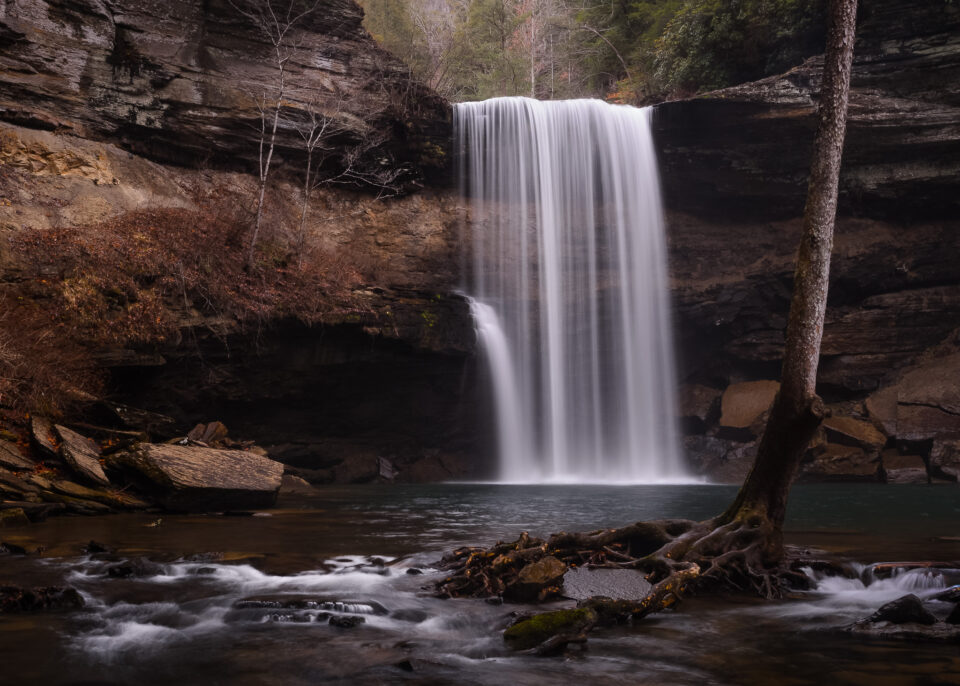
Background Info
Although it may look like I took these photos on the same day, I actually captured them about a month apart (the alternate in November 2014 and the portfolio shot in December 2014).
In this case, I really liked the earlier photo I took, and I was pretty reluctant to abandon it in favor of anything new. Not to mention, I had already edited this photo exactly how I wanted – so, to my eyes, any new pictures I took of this subject fell a bit short.
Looking at the two of them now, I definitely prefer the newer composition. The foreground doesn’t cover any of the waterfall, the top of the photo isn’t as distracting, and the message all-around is much more streamlined. But my attachment to the earlier photo was strong enough to overrule those improvements, at least at first glance.
(As an aside – I really don’t think that I’ve gotten better at fixing that bias in my photography over time. If I visit Dream Lake or the Grand Mosque of Abu Dhabi again and take a slightly better variation of my portfolio image, will I realize it fairly quickly? I suspect not. Hopefully I’d figure it out in the end, given enough time.)
Why I chose the portfolio image:
- More simplicity and clarity in my message, with fewer distracting elements
- Primary subject is distinct, without anything covering it
Why I liked the alternative better at first:
- Because I took it a month earlier, I had edited it already, while the new (unedited) photo looked pretty dull in a side-by-side comparison
- I had formed an attachment to the first photo and had convinced myself it was the “final” image already
Takeaways and Conclusion
The photos above all have fairly different subjects, but the three most successful variations all work well for similar reasons. Each time, my preferred image makes better use of simplicity and sends a clearer message than the alternatives. Along with that, the primary subject is noticeably more distinct in the first and third portfolio image (Grand Mosque and Greeter Falls), and arguably is a bit clearer in the Dream Lake portfolio image as well.
My reason for sticking with the alternates for so long each time was also fairly similar. In each case, before I had a chance to compare the different variations from a photoshoot, I had already settled on the “wrong” one and biased my selection process accordingly. But just because a photo required more effort to capture, or because the in-camera preview looked good, doesn’t make it the best photo you took that day.
Here are some tips I recommend to help select the better version of a photo as often as possible:
- When comparing photos, make sure they’re all in the same stage of editing
- Try to see the photos in terms of storytelling/conveying a message, and ask yourself which one does so more effectively
- Consider waiting a couple weeks to load your photos after you’ve taken them, to help see your work in a more objective light
- Ah, who am I kidding? If you take an amazing photo, of course you’ll want to load it as soon as possible! So, at least go back to that folder at a later date to re-examine the photos you may have missed. Right now’s a pretty good time to do that, if you’re staying home and have some free time
Lastly, I’d like to point out that it’s perfectly fine to prefer one of the alternate photos I showed in this article, rather than the portfolio image in any of these cases. The preferences I talk about above are just my own, and given how similar the alternate/portfolio shots are, I have no doubt that many photographers will have a different opinion.
I hope you enjoyed this article. If anyone is interested, I may decide to write a Part 2; almost every photo in my portfolio has some alternate versions, and it was difficult to narrow down to just three examples above. Or, if you have any other questions, feel free to ask away below!